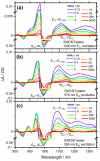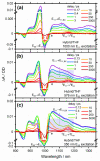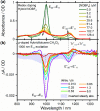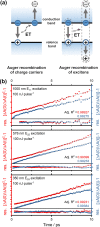Charge Transfer from Photoexcited Semiconducting Single-Walled Carbon Nanotubes to Wide-Bandgap Wrapping Polymer
- PMID: 34055124
- PMCID: PMC8154833
- DOI: 10.1021/acs.jpcc.0c10171
Charge Transfer from Photoexcited Semiconducting Single-Walled Carbon Nanotubes to Wide-Bandgap Wrapping Polymer
Abstract
As narrow optical bandgap materials, semiconducting single-walled carbon nanotubes (SWCNTs) are rarely regarded as charge donors in photoinduced charge-transfer (PCT) reactions. However, the unique band structure and unusual exciton dynamics of SWCNTs add more possibilities to the classical PCT mechanism. In this work, we demonstrate PCT from photoexcited semiconducting (6,5) SWCNTs to a wide-bandgap wrapping poly-[(9,9-dioctylfluorenyl-2,7-diyl)-alt-(6,6')-(2,2'-bipyridine)] (PFO-BPy) via femtosecond transient absorption spectroscopy. By monitoring the spectral dynamics of the SWCNT polaron, we show that charge transfer from photoexcited SWCNTs to PFO-BPy can be driven not only by the energetically favorable E33 transition but also by the energetically unfavorable E22 excitation under high pump fluence. This unusual PCT from narrow-bandgap SWCNTs toward a wide-bandgap polymer originates from the up-converted high-energy excitonic state (E33 or higher) that is promoted by the Auger recombination of excitons and charge carriers in SWCNTs. These insights provide new pathways for charge separation in SWCNT-based photodetectors and photovoltaic cells.
© 2021 American Chemical Society.
Conflict of interest statement
The authors declare no competing financial interest.
Figures









References
-
- Graf A.; Zakharko Y.; Schießl S. P.; Backes C.; Pfohl M.; Flavel B. S.; Zaumseil J. Large scale, selective dispersion of long single-walled carbon nanotubes with high photoluminescence quantum yield by shear force mixing. Carbon 2016, 105, 593–599. 10.1016/j.carbon.2016.05.002. - DOI
-
- Rother M.; Brohmann M.; Yang S.; Grimm S. B.; Schiessl S. P.; Graf A.; Zaumseil J. Aerosol-Jet Printing of Polymer-Sorted (6,5) Carbon Nanotubes for Field-Effect Transistors with High Reproducibility. Adv. Electron. Mater. 2017, 3 (8), 1700080.10.1002/aelm.201700080. - DOI
LinkOut - more resources
Full Text Sources
Other Literature Sources
Research Materials
